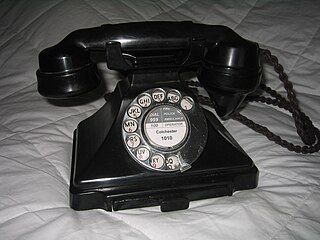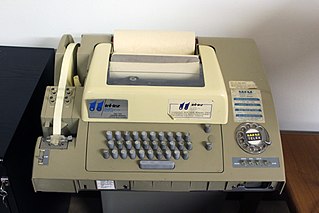Related Research Articles
Present-day telecommunications in Canada include telephone, radio, television, and internet usage. In the past, telecommunications included telegraphy available through Canadian Pacific and Canadian National.

A teleprinter is an electromechanical device that can be used to send and receive typed messages through various communications channels, in both point-to-point and point-to-multipoint configurations.
Direct distance dialing (DDD) is a telecommunication service feature in North America by which a caller may, without operator assistance, call any other user outside the local calling area. Direct dialing by subscribers typically requires extra digits to be dialed as prefixes to the directory telephone number of the destination. International Direct Distance Dialing (IDDD) extends the system beyond the geographic boundaries of the North American Numbering Plan (NANP).

A blue box is an electronic device that produces tones used to generate the in-band signaling tones formerly used within the North American long-distance telephone network to send line status and called number information over voice circuits. During that period, charges associated with long-distance calling were commonplace and could be significant, depending on the time, duration and destination of the call. A blue box device allowed for circumventing these charges by enabling an illicit user, referred to as a "phreaker" to place long-distance calls, without using the network's user facilities, that would be billed to another number or dismissed entirely by the telecom company's billing system as an incomplete call. A number of similar "color boxes" were also created to control other aspects of the phone network.

The North American Numbering Plan (NANP) is a telephone numbering plan for twenty-five regions in twenty countries, primarily in North America and the Caribbean. This group is historically known as World Zone 1 and has the telephone country code 1. Some North American countries, most notably Mexico, do not participate with the NANP.
Subscriber trunk dialling (STD), also known as subscriber toll dialing, is a telephone numbering plan feature and telecommunications technology in the United Kingdom and various Commonwealth countries for the dialling of trunk calls by telephone subscribers without the assistance of switchboard operators.
The public switched telephone network (PSTN) is the aggregate of the world's telephone networks that are operated by national, regional, or local telephony operators. It provides infrastructure and services for public telephony. The PSTN consists of telephone lines, fiber-optic cables, microwave transmission links, cellular networks, communications satellites, and undersea telephone cables interconnected by switching centers, such as central offices, network tandems, and international gateways, which allow telephone users to communicate with each other.
In telephony, multi-frequency signaling (MF) is a type of signaling that was introduced by the Bell System after World War II. It uses a combination of audible tones for address transport and supervision signaling on trunk lines between central offices. The signaling is sent in-band over the same channel as the bearer channel used for voice traffic.

The director telephone system was a development of the Strowger or step-by-step (SXS) switching system used in London and five other large cities in the UK from the 1920s to the 1980s.
The Aeronautical Fixed Telecommunications Network (AFTN) is a worldwide system of aeronautical fixed circuits provided, as part of the Aeronautical Fixed Service, for the exchange of messages and/or digital data between aeronautical fixed stations having the same or compatible communications characteristics. AFTN comprises aviation entities including: ANS providers, aviation service providers, airport authorities and government agencies, to name a few. It exchanges vital information for aircraft operations such as distress messages, urgency messages, flight safety messages, meteorological messages, flight regularity messages and aeronautical administrative messages.

A telephone exchange name or central office name was a distinguishing and memorable name assigned to a central office. It identified the switching system to which a telephone was connected, and facilitated the connection of telephone calls between switching systems in different localities.

33 Thomas Street is a 550-foot-tall (170 m) windowless skyscraper in the Tribeca neighborhood of Lower Manhattan in New York City, New York, United States. It stands on the east side of Church Street, between Thomas Street and Worth Street. Designed in the Brutalist architectural style, it is a telephone exchange or wire center building which contained three major 4ESS switches used for interexchange telephony, as well as a number of other switches used for competitive local exchange carrier services. However, it is not used for incumbent local exchange carrier services, and is not a central office.
In modern day usage, "foreign exchange office" (FXO) and "foreign exchange station" (FXS) refer to the different ends of a telephone line in the context of voice over IP (VoIP) systems and its interconnection with analog telephony equipment. The FXO side is used for the telephone, and the FXS side is the analog telephone adapter.

A telephone number is a sequence of digits assigned to a landline telephone subscriber station connected to a telephone line or to a wireless electronic telephony device, such as a radio telephone or a mobile telephone, or to other devices for data transmission via the public switched telephone network (PSTN), or other public and private networks. Modern smart phones have added a built-in layer of abstraction whereby individuals or businesses are saved into a contacts application and the numbers no longer have to be written down or memorized.
The original North American area codes were established by the American Telephone and Telegraph Company (AT&T) in 1947, after the demonstration of regional Operator Toll Dialing during the World War II period. The program had the goal of speeding the connecting times for long-distance calling by eliminating intermediary telephone operators. Expanding this technology for national use required a comprehensive and universal, continent-wide telephone numbering plan.

PSTN network topology is the switching network topology of a telephone network connected to the public switched telephone network (PSTN).

A telephone exchange, also known as a telephone switch or central office, is a crucial component in the public switched telephone network (PSTN) or large enterprise telecommunications systems. It facilitates the interconnection of telephone subscriber lines or digital system virtual circuits, enabling telephone calls between subscribers.

Telex is a telecommunication service that provides text-based message exchange over the circuits of the public switched telephone network or by private lines. The technology operates on switched station-to-station basis with teleprinter devices at the receiving and sending locations. Telex was a major method of sending text messages electronically between businesses in the post–World War II period. Its usage went into decline as the fax machine grew in popularity in the 1980s.
Common Language Information Services encompasses several products that are in general use by the global telecommunications industry through license agreements. Common Language products combine numerics and mnemonics to establish naming conventions that telecommunication companies use to exchange critical information via Operations Support Systems and other interface mechanisms.
In the North American Numbering Plan, a rate center is a geographically-specified area used for determining mileage and/or usage dependent rates in the public switched telephone network.
References
- 1 2 "CLLI Codes Technical Description". Common Language Information Services. Archived from the original on 24 March 2018. Retrieved 26 March 2018.
- 1 2 "The industry recognized source for routing and rating data". iconectiv.
- ↑ "High-Tech Dictionary - VOIP". ComputerUser, Inc. Archived from the original on 6 July 2008. Retrieved 22 February 2009.
- ↑ "Intercompany Responsibilities Within The Telecommunications Industry" (PDF). ATIS/NIIF 0015 Issue 1.0. Retrieved 2016-04-16.
- 1 2 3 "Intercompany Responsibilities Within The Telecommunications Industry" (PDF). ATIS/NIIF 0015 Issue 1.0. Archived from the original (PDF) on 2012-10-21. Retrieved 2012-06-15.
- 1 2 3 4 COMMON LANGUAGE LOCATION IDENTIFICATION (CLLI) CODE DESCRIPTION, Bell System Practices (AT&T Co. Standard) Section 795-100-100 Issue 5, October 1982
- ↑ "West University Place city [ permanent dead link ]." United States Census Bureau . Retrieved on February 1, 2009.
- ↑ "Southwestern Bell exchange list". Southwestern Bell Telephone. Retrieved 22 February 2009.
- ↑ "Telephone EXchange Name Project". Archived from the original on 3 December 1998. Retrieved 22 February 2009.
- ↑ "Telcodata lookup". Telcodata.us. Retrieved 22 February 2009.
- ↑ "Telcodata lookup". Telcodata.us. Retrieved 22 February 2009.
- ↑ "Telcodata lookup". Telcodata.us. Retrieved 22 February 2009.
- ↑ SWASONXTSG1 on telcodata.us
- ↑ "Local calling guide: NPA-NXX search".
- ↑ OTWAON080MD on localcallingguide.com
- ↑ OTWAON08 - Iona Street, Ottawa on localcallingguide.com
- ↑ "MALTON22CG1". Archived from the original on 2016-10-17.
- ↑ WFISON15RS0 on localcallingguide.com
- ↑ Despite the -CG0 suffix, Kingston's "LIberty 8" exchange (+1-613-54x-xxxx) is a Nortel DMS-100 per KGTNON08CG0 on telcodata.us